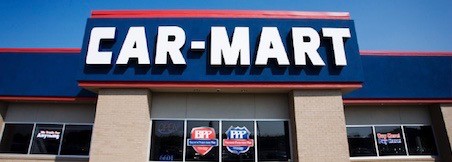Credit squeeze on subprime loans leads business to Car-Mart, other buy here, pay here dealers
by March 14, 2017 10:52 am 600 views

Competition for subprime credit began showing signs of slowing in the fourth quarter of 2016, as serious delinquencies rose and lenders tightened standards for lending. But while the rising delinquencies are cause for concern, the tightening in lending might lead to more business for buy here, pay here dealers.
Nationwide, auto debt rose 5.1% in the fourth quarter, from the same period in 2015, according to the Federal Reserve Bank of St. Louis. In the same period, serious delinquencies, or debt more than 90 days past due, increased 0.4%.
Lenders have been tightening standards not only as a result of rising delinquencies but also because “lenders have stretched repayment terms and offered higher advance rates, resulting in greater loan-to-value ratios,” according to the Federal Reserve. And these changes in lending have started to lead consumers to America’s Car-Mart, the Bentonville-based buy here, pay here used car dealer.
“We’re starting to see a little bit of that,” said Jeffrey Williams, president and chief financial officer of Car-Mart. He said the company started to see this at the first of the year.
While tighter standards could lead some to buy here, pay here dealers, it doesn’t mean the lending for subprime borrowers is going away, said John Hall, associate finance professor at the University of Arkansas at Little Rock. And if they cannot get a loan, public transportation is an option. Also, subprime borrowers don’t necessarily earn low income. They might be able to save their money to pay for a vehicle.
Tim Yeager, finance professor in the Sam M. Walton College of Business at the University of Arkansas and banking chair for Arkansas Bankers Association, said tighter standards would require some buyers to purchase less expensive vehicles, “and others will not be able to buy cars at all. But this may be preferable for the consumers that could obtain the loan with looser standards but then default down the road.” Also, people will keep their older vehicles longer.
In the Little Rock metropolitan statistical area, auto debt of subprime borrowers accounted for 28% of existing auto debt, and in Memphis, it was 38%, according to the Federal Reserve. Subprime debt has risen, and it might lead to “further increases in overall serious delinquency rates.” Much of the financing that was provided to the subprime borrowers in the areas was offered by auto financing companies, not banks or credit unions.
“Some of this subprime financing has attracted some of our customers,” Williams said.
Nearly all of Car-Mart’s customers have deep-subprime credit scores, or a score of less than 550. Williams explained the company fills a need in the market and believes that Car-Mart has the better deal with shorter contract terms at a lower interest rate. Its average contract is more than 30 months with a 16.5% interest rate.
In the fourth quarter, average interest rates fell to 19.03% for used car loans as a result of more loans being given to borrowers with the higher credit scores, according to Experian Automotive. Subprime borrowers accounted for 24.81% of used car loans, down from 26.61% in the same quarter in 2015. For deep-subprime borrowers, it was 5.32%, down from 5.63%.
Also in the fourth quarter, average length of a used car loan was more than 61 months for subprime borrowers and more than 58 months for deep-subprime borrowers. More than 41% of used car loans have term lengths between 61-72 months, and the percentage of loans with terms between 73 and 84 months rose to 18.2%, from 16.4% in the same period in 2015. Hall said he was stunned by the term lengths for used car loans.
“You can get a used car loan for 78 months,” he said.
CREDIT COMPETITION
Low interest rates, low fuel prices and a strengthening economy after the recession led to “robust growth in auto lending,” according to the Federal Reserve.
Until recently, interest rate increases were not being discussed, and lenders were looking to make money. As the economy improved, they looked to the subprime market. It offered a higher yield but with an increased risk for loss. This is referred to as chasing yield, and it’s a concern for regulators, Hall said.
In its recent report on risk in the banking sector, the Office of the Comptroller noted that “as banks competed for market share, some banks responded with less stringent underwriting standards for direct and indirect auto loans.” The increased risks, which included longer term lengths and higher interest rates, were reflected in “lower recoveries at charge-off auto values for both bank loans and securitized auto loans despite relative stability in used auto values.”
Market share of used car financing for buy here, pay here dealers slipped to 11.1% in the fourth quarter, from 11.9% in the same quarter in 2015, according to Experian. Banks also saw market share decline to 35%, from 36.6%. But the following saw market share rise: captive, 8%, from 7.6%; credit unions, 25.4%, from 25%; and financing companies, 20.5%, from 18.9%.
Shares of America’s Car-Mart (NASDAQ: CRMT) closed at $34.20, up 45 cents or 1.33%, on Monday (March 13). In the past 52 weeks, the stock has traded between $47.75 and $19.49.
